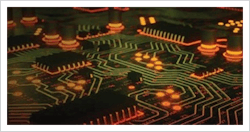As connected devices become smaller with more robust capabilities, engineers have many design aspects to take into consideration—including the increasingly important issues of over-heating as well as managing unwanted frequencies such as electromagnetic interference. These disparate challenges can be difficult to address because they may not emerge until later in the product design cycle, when a full product redesign is not an option.
Fortunately, a simple solution has been found for thermal management and EMI shielding or absorbing — 3M offers thermal interface materials and electromagnetic interference solutions that are easy to design late in the design process, work well and are cost-effective. Specially designed materials that take up minimal space can be placed in applications to address emerging design challenges such as interference reduction or excess heat distribution, making them an easy and ideal way to address issues at any point in the design process.
However, each design challenge can require a unique size and shape of material, which engineers need to receive quickly for prototyping. The steps from determining the right material and the right size to having the proper adhesive cut and shipped can cause delays in the design process.
TTI, in partnership with a 3M preferred converter, offers a nationwide solution as a broadline distributor that can provide the services of a converter along with the logistical support and inventory the organization is known for. This approach will allow more engineers quick, easy and widespread access to customized 3M materials that will solve the thermal and EMI challenges they face increasingly often.
Thermal Management
3M has developed a line of thermal interface materials that can be placed between the heat sink and cooling device to dissipate the excess heat. Highly conformable thermally conductive tapes feature high thermal conductivity and adhesion, allowing them to dissipate heat and quickly and easily be applied to a variety of substrates.
Electromagnetic Interference - (EMI)/Electromagnetic Compatibility (EMC) Application Requirements
Electromagnetic frequencies and static electricity can be produced by anything from smart devices, thunderstorms, solar activity and applications using 5G connectivity. However, EMI can interfere with device performance and potentially cause data delayed readings, higher error rates and slower communication speeds. Design engineers also need to consider EMC standards to ensure the device can function without being affected by or affecting nearby electronics.
3M offers electrically conductive tapes for EMI shielding and grounding applications and EMI absorbers for absorbing applications. Both solutions help protect devices from EMI and ensure they comply with EMC standards. This is a simple solution for a requirement that would otherwise potentially result in an entire electrical system redesign.
An All-In-One Custom Adhesive Solution
Design engineers often need customized thermal management or EMI/EMC solutions after initial rounds of testing. If an engineer wants samples of a certain material or a custom-cut adhesive from a local converter, the company will order a large roll of the specific material and cut it into the shape or dimension required. However, this often results in a delay due to the lead time for the converter to order the appropriate material, which is difficult when the engineer is at a critical point in the design phase—speedy turnaround is paramount. Additionally, some converters will require the customer to purchase the entire roll of material, even if they only need a portion or sample.
TTI’s partnership with a preferred 3M converter allows customers to circumvent many of the challenges faced when ordering specialized materials later in the design cycle.
TTI’s robust service catalog, logistical support and simplified ordering process combined with a converter’s ability to cut, package and customize any 3M material enables design engineers to take advantage of these simple solutions at any point in the design cycle and overcome the challenges of designing connected electronic devices and components.




